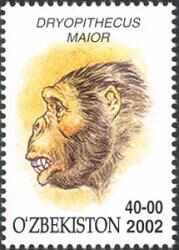
November 9, 2006

How long have people been talking about Dryopithecus as having some bearing on reports of unknown hominoids, those that appear to be more anthropoid than hominid? For over fifty years, it turns out.
Personally, I’ve promoted them since the 1960s (see most recently Bigfoot!, pages 165-166) and I have talked of dryopithecines and their possible dissemination by slave ships for decades. My friends and associates have commented on my and others’ thoughts about this fossil candidate.

In the wake of a photograph of what appears to be an ape, perhaps even a cryptid one, in Florida, discussion has occurred here about the origins of Skunk Apes in America, and the link to Dryopithecus as a possible candidate for some of these reports. Long-time cryptozoologist and good friend Mark A. Hall of Minnesota has written recently of such matters, and today, gives me permission to share the following thoughts[*] with Cryptomundo:

Mark A. Hall writes:
The creatures that resemble the Yeti seem to be few in number. But they are likely to be descendants of the several species of the genus Dryopithecus known from fossils to have lived in Europe several millions of years ago. There are possible relatives among fossils found in Asia and Africa. These apes could have made their way into North and South America as well. They might not have ever been numerous in the New World. No fossils have yet been identified. The American Indians in Louisiana have identified such a swamp creature. They called it Kashehotapalo (“Screams like a woman”) for the sound that it made. [**] This same scream has been associated with modern reports of this ape in North America.
To be specific the Yeti of our time appears to be a likely descendant of an ape such as Dryopithecus laietanus. This fossil ape has been described from remains found in Spain that date back 9.5 millions of years. [***]
The fossil origins of this ape were noted at the time by Peter Andrews and David Pilbeam:
“Dryopithecus was first described three years before Darwin’s Origin of Species was published, and was the first known fossil ape. The type species, D. fontani, is based on a lower jaw with most of its teeth in place; the shaft of a humerus was found later at the same site in the south of France. This gave an early indication that at least this part of the postcranial skeleton was more similar to the corresponding parts of living great apes than were the jaws and teeth, which retained many characters unchanged from the ancestral hominoid form.” [****]
The Spanish find of 1996 was the best record of Dryopithecus so far. There was no agreement on the place of this ape in the scheme of primate evolution. There has been no professional consideration that this unique ape could be the ancestor of the Yeti and might still be around. The first association of Dryopithecus with the Asian Yeti goes back to 1950 when Ivan Sanderson suggested such a link. [*****]
*Mark A. Hall, “The Yeti in Iowa,” Wonders , Volume 9 (March 2005).
**Mark A. Hall, The Yeti, Bigfoot & True Giants (MAHP: Wilmington, NC, 1997), 21-22.
***Salvador Moya-Sola and Melke Kohler, “A Dryopithecus skeleton and the origins of great-ape locomotion,” Nature 379:156-9 (11 January 1996).
****Peter Andrews and David Pilbeam, “The nature of the evidence,” Nature 379:123-4 (11 January 1996).
*****Ivan T. Sanderson, “Abominable Snowman,” True, September 1950.
[Also, for more information on this specific genus, please see John Hawkes weblog’s Dryopithecus overview.]
About Loren Coleman
Loren Coleman is one of the world’s leading cryptozoologists, some say “the” leading living cryptozoologist. Certainly, he is acknowledged as the current living American researcher and writer who has most popularized cryptozoology in the late 20th and early 21st centuries.
Starting his fieldwork and investigations in 1960, after traveling and trekking extensively in pursuit of cryptozoological mysteries, Coleman began writing to share his experiences in 1969. An honorary member of Ivan T. Sanderson’s Society for the Investigation of the Unexplained in the 1970s, Coleman has been bestowed with similar honorary memberships of the North Idaho College Cryptozoology Club in 1983, and in subsequent years, that of the British Columbia Scientific Cryptozoology Club, CryptoSafari International, and other international organizations. He was also a Life Member and Benefactor of the International Society of Cryptozoology (now-defunct).
Loren Coleman’s daily blog, as a member of the Cryptomundo Team, served as an ongoing avenue of communication for the ever-growing body of cryptozoo news from 2005 through 2013. He returned as an infrequent contributor beginning Halloween week of 2015.
Coleman is the founder in 2003, and current director of the International Cryptozoology Museum in Portland, Maine.
Filed under Abominable Snowman, Breaking News, Cryptomundo Exclusive, CryptoZoo News, Cryptozoology, Yeti